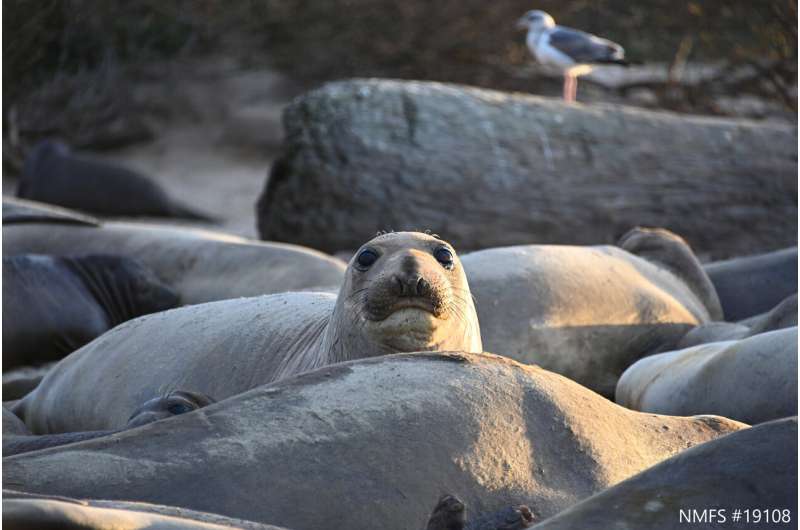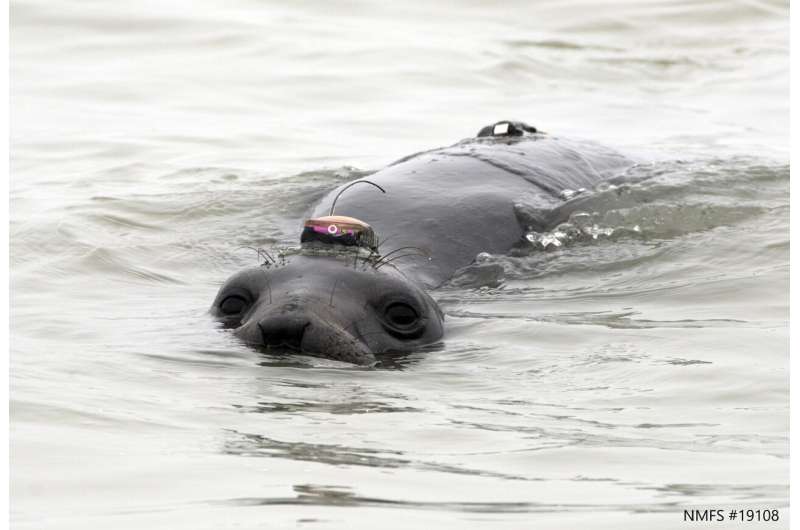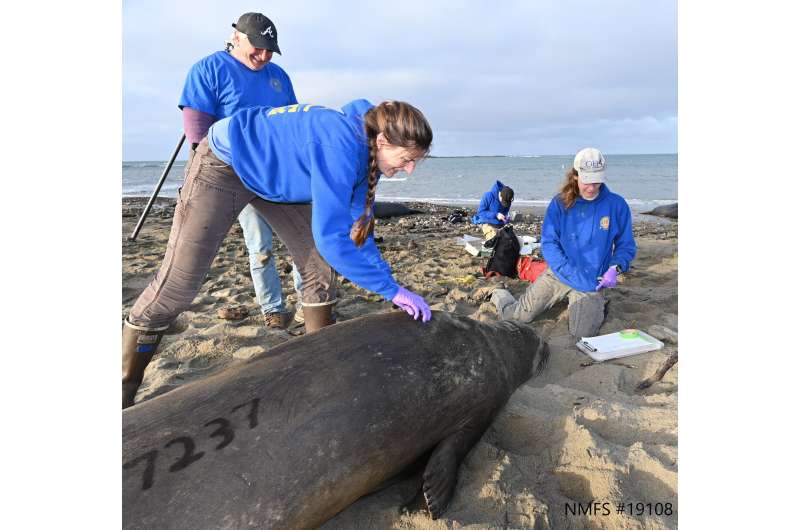For migrating elephant seals, 'lightscapes of fear' shape feeding, resting strategies

Every year in May, female elephant seals leave the beaches in California where they gave birth, nursed young, and molted, to embark on a seven-month foraging migration across the North Pacific Ocean. There is danger in the open ocean, however, and the seals must avoid becoming prey themselves as they hunt fish and squid to regain the weight they lost during months on the beach with only one short foraging trip between nursing and molting.
A new study led by scientists at UC Santa Cruz shows that the elephant seals take more risks early in the migration when their stores of body fat are lowest, and change their activity patterns strategically as their body condition improves. With more fat on their bodies, the seals increasingly prioritize safety over feeding.
The study, published March 17 in Science Advances, is the first to continuously measure changes in behavior relative to body fat, resolving a decades-old question about how wild animals balance risks and rewards.
"Theory predicts that fat animals take fewer risks, but it's very difficult to measure body condition continuously in wild animals," said first author Roxanne Beltran, assistant professor of ecology and evolutionary biology at UC Santa Cruz. "Our results show that fat seals prioritize safety, and skinny seals prioritize feeding."
The researchers outfitted 71 adult female northern elephant seals with satellite tags and time-depth recorders, which allowed them to track the seals' movements and diving patterns. The migration covers about 6,000 miles (10,000 kilometers) across the North Pacific Ocean. Throughout this journey, the elephant seals travel in an uninterrupted series of dives, averaging 23 minutes per dive with just 2 minutes at the surface to breathe between dives.

For elephant seals, the surface waters are a dangerous place where they are most vulnerable to attacks by sharks and killer whales, so they minimize the time spent at the surface. Sharks and killer whales are visual predators, so elephant seals are safer at night and in the depths where light doesn't penetrate. The result is what Beltran and her coauthors call "lightscapes of fear" that shape animal behavior in the open ocean.
"We don't know a lot about predator-prey dynamics in the open ocean because there are so few sightings of attacks, but we regularly observe elephant seals on the beach with shark bites," Beltran said.
Tracking data reveal several different types of dives, including foraging dives, when the seals swim down and pursue prey at depth; transit dives with no feeding activity; and rest dives, when they drift passively at the bottom of the dive and are presumably sleeping.
The drift dives enabled the researchers to calculate how much body fat the seals had based on their buoyancy in the water.
"It gives us a nearly continuous record of how fat they are, which is unparalleled for any wild animal other than elephant seals," Beltran said. "At the beginning of the migration, they are really skinny and they sink through the water column. As the feeding migration progresses, they slowly gain weight and their buoyancy becomes less negative until, at some point, they switch to positive buoyancy and stay positive for the rest of the trip."

Elephant seals do most of their feeding at night, when their prey are closer to the surface. Their rest dives tend to be in the early morning around sunrise, after a long night of foraging.
The timing of those rest dives changes, however, as the seals' body condition improves. Seals in poor body condition started their drift dives just after sunrise, whereas seals in good condition started their drift dives just before sunrise. As a result, the proportion of rest occurring during daylight decreased from 80 to 30 percent.
During drift dives, when they are presumably sleeping, the seals are especially vulnerable, making it safer to rest at night, before sunrise. But that means giving up some prime foraging time. Elephant seals feed during the day, too, but they have to dive deeper and their foraging is less efficient. With the best foraging and the safest resting times occurring at night, the seals have to choose between competing priorities.
As their body condition improved throughout the migration, drift dives occurred progressively earlier with respect to sunrise, indicating a shift in their priorities from feeding to safety. Seals in good body condition also started their drifts at greater depths. This makes sense considering that a fat seal drifts upward toward the sunlit surface.
"Light is a fundamental environmental constraint that these animals are using strategically to maximize rewards and minimize risks," Beltran said. "In the ocean, light is an interesting way to look at risk-reward tradeoffs because it integrates time and space, especially for a migratory species that travels across time zones and latitudes with constantly changing day lengths."
This study was a collaborative effort based on data acquired through the long-running UCSC elephant seal research program led by coauthor Daniel Costa, distinguished professor of ecology and evolutionary biology and director of UCSC's Institute of Marine Sciences. For over three decades, UCSC researchers have been tagging and studying elephant seals at Año Nuevo Reserve, managed by the UC Natural Reserve System.
More information: R.S. Beltran el al., "Lightscapes of fear: how mesopredators balance starvation and predation in the open ocean," Science Advances (2021). advances.sciencemag.org/lookup … .1126/sciadv.abd9818
Journal information: Science Advances
Provided by University of California - Santa Cruz




















